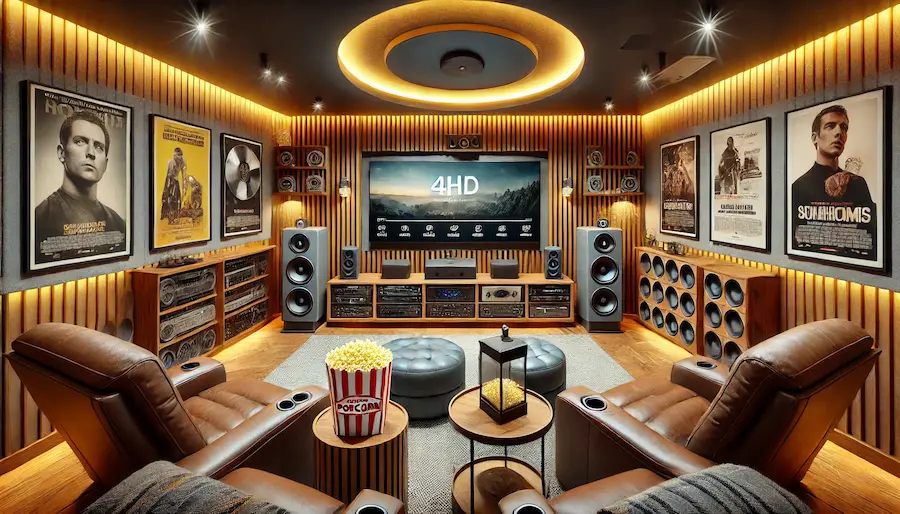Home entertainment systems today are not just a luxury, only affordable to the rich and famous. They are a necessity, and thanks to technological innovations, there is a setup suitable for every home based on their budget.
A home entertainment system offers an immersive and enjoyable experience for movie buffs, audiophiles, and game lovers. Setting up a home entertainment system is easy; however, selecting the best components and configuring them for optimal performance can be daunting.
This guide will help you choose the perfect components, learn how to carefully select the most suitable room size, and optimize for a superb entertainment experience.
Table of Contents
Location
Your entertainment system should be set up in a space that does not interrupt the business of your home. For instance, you do not want the sound disturbing your kids sleeping or preventing you from concentrating at work, if you work from home.
Understanding the difference between a home theater and a home cinema can help you decide the perfect location for your setup.
A home theater setup provides a movie-going and concert-vibe experience in your home. It is a great place to watch movies, play sports games, and enjoy your favorite TV show with family and friends.
Most of the time, a home theater is set up in the living room or family room. Experts recommend the section, for it should be about 20 feet long and 13 feet wide.
A home cinema, on the other hand, is a dedicated room for entertainment system setup. It can be a spare bedroom or garage if it is not initially included in the building plan.
Unlike a home theater, which is in a room that serves other functions, a home cinema allows for detailed customization and installation to provide the best audio and visual experience.
Components
The essential components of a home entertainment system setup include:
1. Television or video projector
The display screen is the centerpiece of your home entertainment system. It can either be a television (TV) or a projector.
When deciding between either, consider factors such as space, display technology, and preferred screen size. TVs are great for convenience and bright rooms, while projectors offer a cinematic feel in a controlled environment.
A projector may not be suitable for home theater considering the distance between the display and chairs. TVs come in different sizes and standard quality, while the image quality of a projector may decrease as you adjust the display size.
2. Sound system
Invest in a quality sound system to create a cinematic audio experience. Some TVs are designed with good speakers, but for a great experience, you will need multiple speakers strategically placed around the room.
A soundbar is a space-saving option for smaller rooms, but surround sound systems offer a more immersive experience.
3. Media player or streamer
Choose a media player or streaming device that supports the latest media technology for easy integration with different gadgets and entertainment experiences.
Smart TVs, for instance, allow direct streaming of movies and music via the internet.
4. AV or surround sound receiver
An AV receiver acts as the control center, connecting your source devices, like Blu-ray players, streaming boxes, and gaming consoles, to your display and speakers.
5. Connection cables and speaker wire
Regardless of the features of your display, sound system, and media player, you will need some connection cables. You will need cable to power your TV or projector, for instance.
Likewise, you might need cables to connect your AV or media player to the display. TVs and sound systems with the latest technology, like Bluetooth, will reduce the cables and wires you will need for the setup.
6. Home entertainment center
Home entertainment centers are designed to house the components you need for your setup, keeping them well-arranged, protected, and aesthetically pleasing.
Choose a home entertainment center that best fits your space for the best look and performance.
Optimization
It is not enough to install all the needed components for your setup; optimizing them will ensure a high-quality display and sound.
Position matters
Proper placement of the speaker is crucial for surround sound. Check the manufacturer’s instructions for optimal placement of speakers based on your setup.
When positioning your speakers and subwoofer, avoid placing them flush against any walls.
Calibration is key
Once all components of your entertainment system setup are complete, calibrate it to fine-tune the audio and video quality for the best possible experience.
For an immersive sound experience, your speakers should be as close to your head height as possible.
The screen height of your TV should be about one-third of the distance from the display to your seats. Ensure the display is on the side of the wall away from direct light.
Projectors should be placed in the center of the room for the best image quality.
Comfort counts
Do not sacrifice your comfort for any components. Invest in comfortable seats for those long movie marathons and favorite TV programs.
For optimal seat arrangement, ensure adequate legroom and distance from the screen. For smaller areas, consider recliners.

